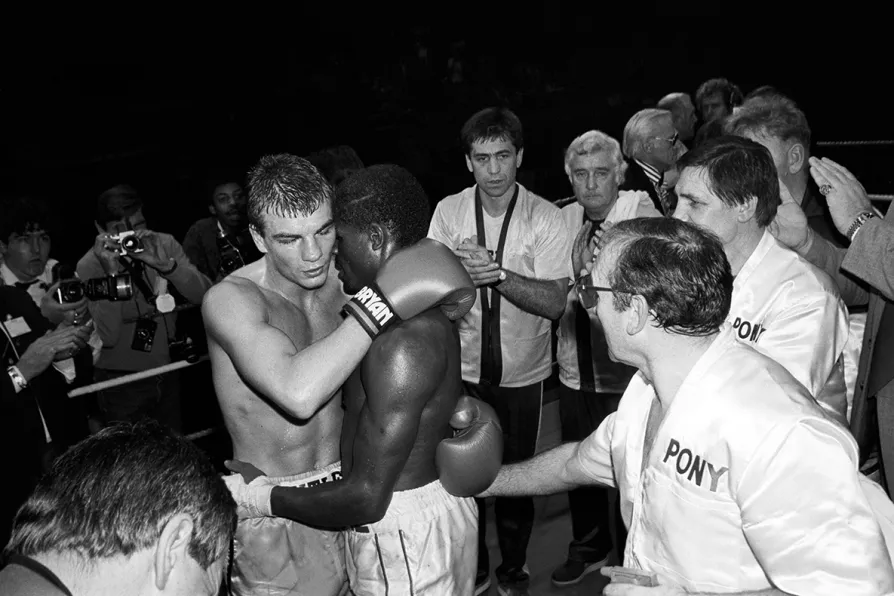JAMES NALTON on Munyua’s stinging success at the World Darts Championship
From Canning Town to championship glory, Mark Kaylor’s journey mirrored a decade of upheaval, resilience, and raw working-class pride, writes JOHN WIGHT

 The victor and the vanquished exchange hugs after Mark Kaylor (left) knocked out opponent Errol Christie in the eighth of their scheduled 12 round final eliminator middleweight contest, November 5, 1985
The victor and the vanquished exchange hugs after Mark Kaylor (left) knocked out opponent Errol Christie in the eighth of their scheduled 12 round final eliminator middleweight contest, November 5, 1985
WHEN Mark Kaylor, whose death at age 64 was recently announced, made his professional debut against Peter Morris at the Royal Albert Hall in October 1980, Thatcher had been ensconced in Downing Street a year into her decade-long rule.
And what a monumental year it had been.
It began with a national strike by steelworkers in early January over pay, and was punctuated thereafter in April by the British African colony of Rhodesia declaring its independence as the newly established state of Zimbabwe. In a sign of things to come, the St Paul’s riots in Bristol erupted that same month, while in May the SAS stormed the Iranian embassy live on national television to introduce themselves and their mythology to the world.
On May 10 1980, Mark Kaylor’s own beloved West Ham United won the FA Cup for the third time in the club’s history. By the 16th of that month there was less to celebrate with the announcement that inflation had risen to a postwar record of 21.6 per cent, to thus confirm that the consequences of Thatcher’s free-market economic experiment had begun to bear its bitter fruit.
Later, on May 27, an inquest into the death of Blair Peach — killed during a demonstration against the National Front the year before — returned a verdict of misadventure in what stands, still today, as one of the most egregious Establishment stitch-ups ever conjured.
Nottingham Forest, returning to football, succeeded in winning the European Cup for the second year running, with a 1-0 victory over Hamburger SV in Madrid at the tail end of May, while at the beginning of August Thatcher handed the keys to the property of the 12,000th British working-class family who had availed themselves of her “right to buy” council housing scheme.
Meanwhile, the murderous campaign of the Yorkshire Ripper, still at this point yet to be caught and unveiled as Peter Sutcliffe, continued later that same month with the slaying of Marguerite Walls in Leeds.
These and other major events marked the beginning of arguably the most consequential and impactful decade in British postwar history. It was also a decade in which British boxing, both amateur and professional, produced some of its most iconic proponents, with Canning Town’s Mark Kaylor prominent among them.
This product of London’s equally iconic East End, Kaylor campaigned at middleweight and quickly amassed a cult following. Along with the likes of Tony Sibson, Alan Minter, Herol Graham, Frank Bruno and Lloyd Honeyghan, Maurice Hope and Jim Watt et al, his name became and remains inextricably associated with the ’80s. His precocious talent, demonstrated during his amateur career, was such that when he made his debut at the aforementioned Royal Albert Hall, he was just 19-years-old.
Managed and trained by Terry Lawless at his legendary gym on Barking Road, located above the Royal Oak pub, by 1983 Kaylor had to his name an impressive record of 23 fights with zero losses. He was now, it was felt, ready to challenge for his first professional honours in the shape of the British and also Commonwealth middleweight titles against Roy Gumbs. At a packed Alexandra Palace in London’s Muswell Hill on September 14 of that year, Kaylor climbed off the canvas in the fourth round to go on and stop Gumbs in the fifth.
Mark Kaylor in the ring was more artisan than artist. What he lacked in fluidity and rhythm, he made up for in tenacity and the willingness to stand and trade. It dictated that every contest he fought was the boxing equivalent of the Gunfight at the OK Corral. This was never more evident than when he met Errol Christie at Wembley Arena on November 5 1985. Never had Guy Fawkes night seen such fireworks in a British boxing ring.
Christie, who himself passed away in 2017, was as tough a British fighter as they come. From Leicester, his detestation of Kaylor was elemental. Indeed, they despised one another to the point of engaging in fisticuffs at the pre-fight press conference at the then Stakis Regency Casino in central London.
The event was underpinned by the racial tensions that have sadly but periodically divided the country’s working class. Errol Christie may have been captain of the English amateur team in his time, but in the context of his fight against West Ham’s Mark Kaylor on that cold November evening in 1985, he was black and thus not truly English.
Mark Kaylor was not responsible for the racial undertones to this bitter clash, but as a fighter and a young man in his feral prime, he could not have been unaffected by them. This said, his own animus towards Errol Christie was that of a fighter rather than crusader. Confirmation in this regard when after stopping him in the eighth round, he did not hesitate to go over to Christie in his corner to pay his respects.
Mark Kaylor occupies a place in the history of British boxing few have matched, regardless of titles won and honours achieved. A working-class East End hero to many in his time, his was a ring career defined by big nights in front of packed, raucous crowds.
After his last fight, which ended in defeat against James Cook at Bethnal Green’s York Hall in 1991, he decamped to the United States, where he embarked on a second career as an aerobics instructor.
Mark Kaylor leaves behind a legacy of great nights in venues across London. This during a decade in which greatness for the working class was largely measured in the ability to navigate Thatcher’s idea of society being consonant with the law of the jungle.
Mark Kaylor (May 11 1961 - November 16 2025).










